2 Traveling Farmer
Most farmers dig in the same soil their whole lives, becoming experts on their plot of earth. I took a different path; a path of discovery, shared cultural understanding, a path of cross-pollination. Berthoud was a small agricultural community on the Piedmont of the Rocky Mountains. Located 50 miles north of Denver, this area provided a laid-back environment that shaped my life. On the farm, at the age of 12, I was breaking horses and driving tractors.


Working the soil and raising livestock led to understanding how to make things happen and gave me a foundation for further study of world agriculture. During Jr. High School, I caught a calf at the National Western Stock Show, and I kept the calf to fatten and bring it back to the Show the following year. I had several Future Farmers of America (FFA) projects with pigs, sheep, cattle, and horses. I started with a pregnant gilt, and when I finished High school, I had over one hundred pigs. Proceeds provided the tuition for my first year of college. I also used an acre of our farmland to grow hybrid seed corn for a hybrid seed company. I spent that summer detasseling one variety of corn that was pollinated by another variety. They paid me $2000, a lot of money in 1957!
Beyond the outdoor activities on the farm, I had my share of working indoors. Having milked our two cows, I processed the milk in the house by allowing the milk to sit for a day in the refrigerator until the cream came to the top. I would skim off the cream with a large spoon and place it into another container to sit for a few days until it started to coagulate. We churned the cream until butter began to form into clumps. Those clumps were slightly salted, kneaded, placed into molds, and stored in the refrigerator. The remaining liquid was saved as buttermilk. There was also the skim milk, which had been separated from the cream. In the end, we had several products to use, give away, and sell: whole unpasteurized milk, cream, skim milk, butter, and buttermilk. I contributed to these processes, particularly the churning of the butter.

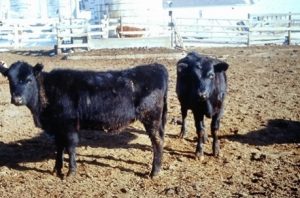
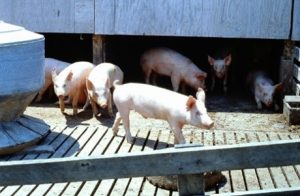 Me standing in front of Berthoud High School upon returning from the Peace Corps in 1966, my catch-it calves in 1956, and my FFA pigs in 1958. Photos by Rick Bein.
Me standing in front of Berthoud High School upon returning from the Peace Corps in 1966, my catch-it calves in 1956, and my FFA pigs in 1958. Photos by Rick Bein.
After leaving Berthoud, I struggled with 2 years of college and chose to join the Peace Corps. That decision significantly altered my life. As an agricultural extensionist in the Brazilian frontier, I learned the ways of the tropical environment, the Portuguese language, and found my passion. This 2-year experience sparked my wanderlust and set me on a lifelong course examining environments and their cultures.
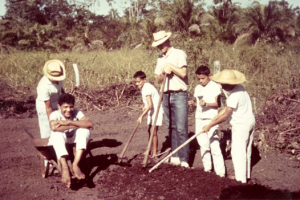 In one Peace Corps activity, I developed a vegetable garden club in Pedro Gomes, Mato Grosso, Brazil. I am teaching twelve-year-old boys how to prepare a garden bed.
In one Peace Corps activity, I developed a vegetable garden club in Pedro Gomes, Mato Grosso, Brazil. I am teaching twelve-year-old boys how to prepare a garden bed.
I returned to Colorado with a new perspective and purpose. Colorado University provided the opportunity to explore academia and discover the discipline of Geography, in which I received my Bachelor of Arts in 1969. At the University of Florida, I wrote my master’s thesis, measuring and mapping the southerly shift of citrus growing in Florida. I was offered an assistantship to begin working on the PhD. In 1971, I received a Dissertation Fulbright grant to return to Mato Grosso, Brazil, where I focused my research on the environment of two agricultural colonies.
 Florida citrus gradually migrated down the peninsula as southern Florida began to open up. This Orange Grove is located near Orlando. Photo by Rick Bein, 1970.
Florida citrus gradually migrated down the peninsula as southern Florida began to open up. This Orange Grove is located near Orlando. Photo by Rick Bein, 1970.
 Horse drawn plow was being used to till the recently cleared tropical forest. Chard tree trunks remained from the burn. Ashes provided fertilizer for the crops but dissipate after three years. The natural regrowth of the forest was hampered by the invasion of exotic African grasses and their periodic burning. Cattle ranching then took over. Photo by Rick Bein, 1972
Horse drawn plow was being used to till the recently cleared tropical forest. Chard tree trunks remained from the burn. Ashes provided fertilizer for the crops but dissipate after three years. The natural regrowth of the forest was hampered by the invasion of exotic African grasses and their periodic burning. Cattle ranching then took over. Photo by Rick Bein, 1972
My first professorial position started in 1974 and lasted three years at the University of Khartoum in Sudan, where I taught a variety of geography courses and studied the agricultural environments of the Sahel, the Nile, and the humid tropics of southern Sudan.
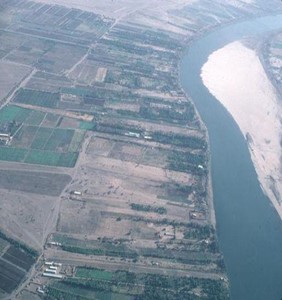
Agriculture of the Nile has a 4000-year tradition that continues south from Egypt into Sudan. Narrow farm strips reach from the water’s edge and extend across to the flood plain to the edge of the Sahara Desert. Air photograph taken from a commercial plane by Rick Bein in 1975.
The annual Blue Nile flood fertilizes the almost level floodplain with silt deposits that have supported agriculture for thousands of years. Thin linear farms extend outward from the edge of the Nile, reaching out to the edge of the Sahara Desert. As the flood recedes, sloping land is exposed and is also cultivated. This is called the Gerif and is only visible during low water times. After the flood, water is pumped onto the broad floodplain to irrigate the narrow plots ranging in size from 2 to 4 hectares. This ancient system is changing with the installation of a series of dams.
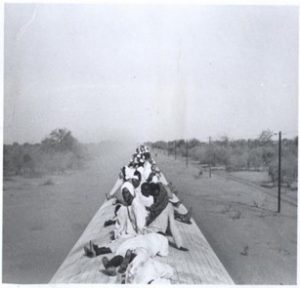 Train carries migrants along the Sahel from Darfur to communities along the Nile. Men ride on top of the train for free while wives and children pay to ride inside. Photo by Rick Bein, 1975
Train carries migrants along the Sahel from Darfur to communities along the Nile. Men ride on top of the train for free while wives and children pay to ride inside. Photo by Rick Bein, 1975
I spent one month in 1976 exploring the tropical forest area of Equatoria Province in southern Sudan, where subsistence agriculture included sorghum, millet, cassava, and a variety of other crops. Many of the farmers had recently returned from exile in Uganda to claim their abandoned farmlands, which had been restored by the 10-year fallow period.
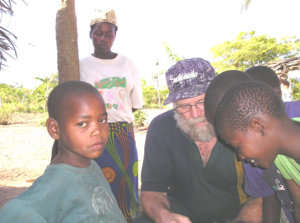
I am showing rural children how my camera works in southern Sudan. Photo by designated villager 1976.
Upon return to the USA, I took my family to the land of spring wheat in North Dakota. I had an excellent year at the University of North Dakota, where I was mentored by Bill Dando in publishing academic writings on the farming traditions of Sudan. From there, Indiana University Purdue University Indianapolis (IUPUI) hired me to develop a Geography Department and to pursue my interest in tropical agriculture.
During the 1980’s an Anthropologist colleague and I developed summer field courses to study various parts of Mexico and Brazil.
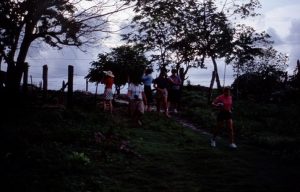

IUPUI students are examining land use in Mexico. Photo by Rick Bein, 1985. Hatchling turtles emerging from the sand in Costa Rica, where I took student volunteers to protect endangered sea turtles. Photo by Rick Bein, 2001.
For the 40 years at IUPUI, I remained committed to the exchange of environmental and agricultural ideas with periodic trips abroad and notable intermittent absences to teach three years at the University of Technology in Papua New Guinea, one year at Eduardo Mondlane University in Maputo, Mozambique, and two separate semesters at Moi University in Kenya.
At the University of Technology on the outskirts of the city of Lei, Papua New Guinea, I was the founding director of the “Environmental Research Management Center” housed in the Department of Forestry. My main mission was to promote environmental awareness in the community. One of my tasks was to encourage the academic departments to include environmental concepts in their teaching. I taught Environmental Conservation in the Forestry Department. The Village Development Trust (a not-for-profit organization) asked that I join in a biodiversity research project working in the coastal village of Lababia. There, the villagers and I developed a biodiversity trail from sea level up a six-thousand-foot mountain.
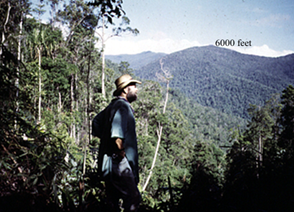
I am looking at Blue Mountain, where the Lababia villagers and I developed a scientific study transect to enable biologists to document the biodiversity of the virgin rainforest in Lababia, Papua New Guinea. Photo by Rick Bein, 1997.

Kenyan Farmer shows how she merges her different crops. Photo by Rick Bein, 2008.
In Mozambique and Kenya, multi-cropping enables continuous cultivation with the symbiosis of different crops supporting each other. Semi-subsistence farming feeds the families and, in good years, earns some money. I refer to this as “four-story agriculture,” where scattered coconut trees tower over dispersed fruit trees, with cassava and low-growing vegetables below. At IUPUI, I remained committed to researching agricultural geography while teaching Geography of Soils and Environmental Conservation.
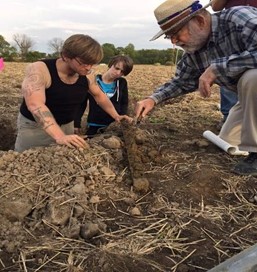 My Soils Geography students and I are examining soil taken from an Indiana soil pit. Photo by Rick Bein, 2003.
My Soils Geography students and I are examining soil taken from an Indiana soil pit. Photo by Rick Bein, 2003.
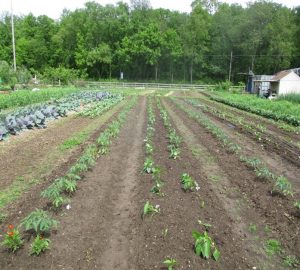 Indy Urban Acres is producing vegetables for the Indianapolis food pantries. Photo by Rick Bein 2019
Indy Urban Acres is producing vegetables for the Indianapolis food pantries. Photo by Rick Bein 2019
Even now, in retirement, I have joined a research team to study the spatial variation of urban agriculture in Indianapolis.
My travels have necessitated the acquisition of the local languages; I speak fluent Portuguese and have a working knowledge of Spanish, Arabic, Swahili, and Tok Pisin. Through my career of teaching, I feel I have impacted students worldwide with inspiration to enhance their careers in education, business, and governmental service. In addition to the increased understanding of agriculture, my hope is that these seeds blossom into a shared understanding of the value of disparate cultures.

